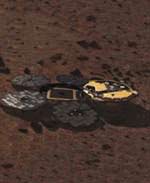
Image credit: Beagle 2
No contact has been made with the Beagle 2 lander, despite repeated efforts over the last few days to communicate via the Mars Express and Mars Odyssey spacecraft and the Jodrell Bank radio telescope in Cheshire, UK.
At a press briefing in London this afternoon, members of the Beagle 2 team described the latest efforts to contact their missing lander.
“We haven?t found Beagle 2, despite three days of intensive searching,” said Professor Colin Pillinger, lead scientist for Beagle 2. “Under those circumstances, we have to begin to accept that, if Beagle 2 is on the Martian surface, it is not active.
“That isn?t to say that we are going to give up on Beagle. There is one more thing that we can do – however, it is very much a last resort. We will be asking the American Odyssey spacecraft (team) tomorrow whether they will send an embedded command – a hail to Beagle with a command inside it. If it gets through, it will tell Beagle to switch off and reload the software. We are now working on the basis that there is a corrupt system and the only way we might resurrect is to send that command.”
“We can also ask Mars Express to send that command. However, they cannot send it probably until the 2 or 3 February,” he added.
“We?ll move with the next phase in the search for Beagle 2,” said Professor Pillinger. “We have discussed on our side of the house what we intend to do in the future. We are dedicated to trying to refly Beagle 2 in some shape or form, therefore we need to know how far it got because we need know which parts of this mission we don?t have to study in further detail.”
Detailing the efforts to contact Beagle 2 in recent days, Mark Sims, Beagle 2 Mission Manager from the University of Leicester, explained that the lander should have entered an emergency communication mode known as CSM2 no later than 22 January. In this mode, the spacecraft?s receiver is switched on throughout daylight hours on Mars. The only possible explanation that no communication has been established during the last few days is that the lander?s battery is in a low state of charge.
Meanwhile, the academia-industry “Tiger Team” at the National Space Centre in Leicester is beginning to concentrate on detailed analysis of the possible causes for failure of the mission and the lessons that can be learned for future missions.
The analysis of the mission now under way includes an assessment of the landing site ellipse from orbital images, reanalysis of atmospheric conditions during the entry into the Martian atmosphere on 25 December, examination of the separation from Mars Express and of the cruise phase preceding arrival at Mars.
One extremely useful piece of evidence could be provided by an image of the lander. The team is hoping that the High Resolution Stereo Camera on Mars Express or the camera on board Mars Global Surveyor may eventually be able to capture an image that reveals its location on the Martian surface.
Original Source: PPARC News Release
